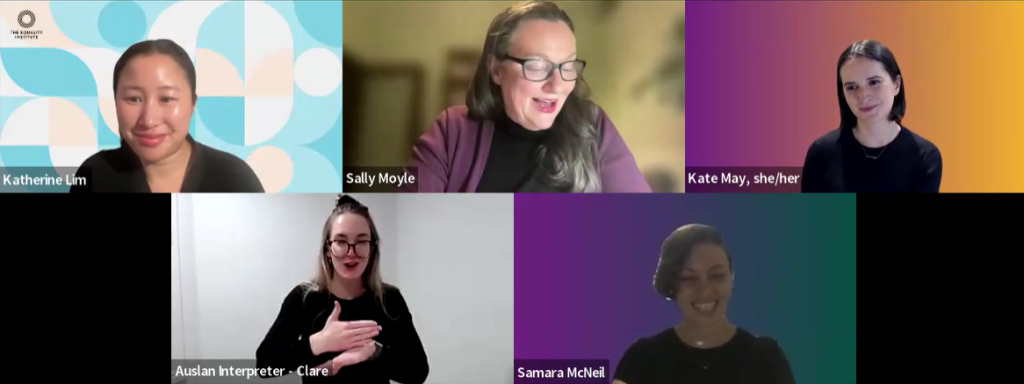
What is Gender -Responsive Health?
“A gender-responsive health system is a more effective and efficient system,” said Health Promotion and Communications Consultant Kate May during a panel discussion to launch the Australian Women’s Health Alliance’s new e-learning course.
The course ‘Introduction to Gender-Responsive Health’ is now live and freely available on the Alliance website.
Australian Women’s Health Alliance members and invited speakers launched the course during a webinar hosted by MC Sally Moyle. The webinar provided an overview of the motivations for developing the course, as well as a tour of the features.
This was followed by a panel discussion between Aboriginal medical doctor and Chair of Violence Prevention Australia, Dr Samara McNeil, Health Promotion and Communications Consultant Kate May and Feminist Leadership Specialist Katherine Lim.
Can we build a more gender-responsive system?
The panel explored what a successful gender-responsive health care system looks like in Australia, and what’s needed to achieve it.
Panellists agreed that while the Australian system can be made more gender-responsive, there are a wide range of barriers that women and gender diverse people face.
“We know that being a female, and being from a certain postcode are 2 independent risk factors for cardiovascular disease, heart attacks and strokes. And so having them combined puts you at higher risk,” said Doctor Samara McNeil.
Katherine Lim from The Equality Institute reinforced the value of the Alliance’s new course in providing tangible steps for learning and action.
“It’s easy to feel like we’re just small cogs in the system, and we don’t have the power to change anything. But change is absolutely achievable…if you’ve had a chance to do this course it’s really great at providing that translating role between the current evidence base and best practice and how to apply it wherever you are in the health system.”
Kate May agreed with this and said the health system can definitely be made more gender-responsive.
“Systems are not immovable objects, they’re made by people. Change is always possible,” she said.
Who is this course for?
Gender-responsive health seeks to address the inequalities in health outcomes, including those experienced by women and gender diverse people.
This course is for anyone who plays a role in the health and wellbeing of their communities.
Dr Samara McNeil, who has reviewed the course. recommended it to a wide audience.
“Wholeheartedly I think this module should be part of our mandatory training,” she said.
It will be of benefit to individuals and workplaces across the full range of health and social care settings. It is self-paced and can be completed by individuals and teams.
The first module of the course is available now and remaining modules will be released later this year.
Acknowledgments
We would like to acknowledge and warmly thank the individuals and organisations who helped us develop this e-learning course, including those listed below. We couldn’t have done it without you.
Brittney Andrews, Deb Barndon, Sara Berent, Bianca Blackmore, Alba Brockie, Jennifer Cox, Antonio Di Dio, Rachel Grove, Amanda Hall, Mali Herman, Amy James, Ximena Jimenez, Bonnie Laxton-Blinkhorn, Katherine Lim, Kate May, Jackie McMillan, Dr Samara McNeil, Editt Melgarejo, Arianna Menzies, Nicole Milanko, Sally Moyle, Jordan Nash, Kate Robinson, Julia Symes APD, Meredith Turner, Jana Ventura, Mishelle Vitellaro-Young and Naomi Weatherburn-Reeves.
If you were involved in helping us develop this course and would like to be acknowledged, please email sienna.aguilar@australianwomenshealth.org.